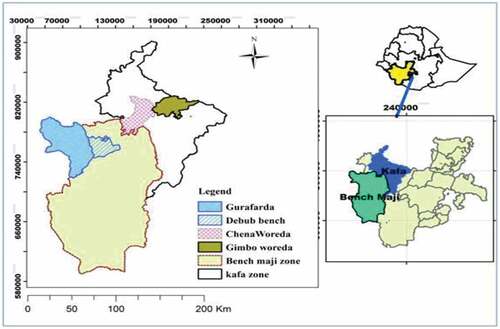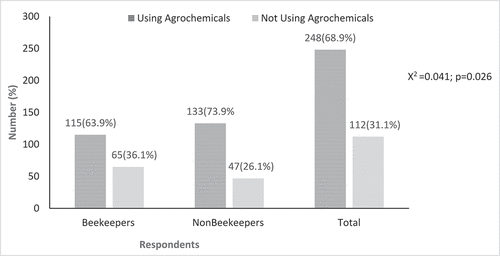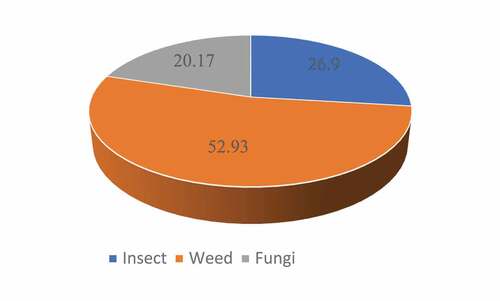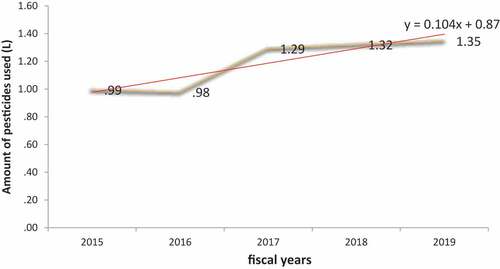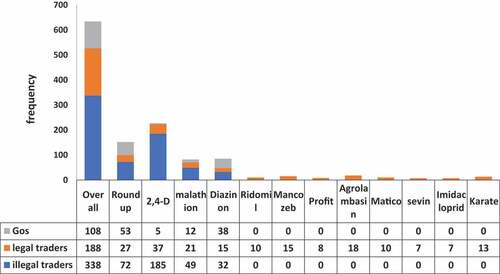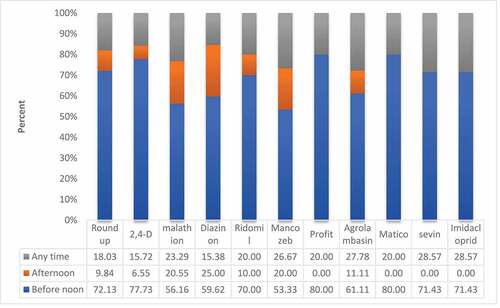 ?Mathematical formulae have been encoded as MathML and are displayed in this HTML version using MathJax in order to improve their display. Uncheck the box to turn MathJax off. This feature requires Javascript. Click on a formula to zoom.
?Mathematical formulae have been encoded as MathML and are displayed in this HTML version using MathJax in order to improve their display. Uncheck the box to turn MathJax off. This feature requires Javascript. Click on a formula to zoom.Abstract
The study was conducted in Kafa and Benchi-Sheko zones with an intention to identify types of pesticides, their utilization, and impacts on beekeeping. Purposive sampling was used for study sites selection. Accordingly, a total of four districts from two zones: Debub Benchi and Guraferda from Benchi Sheko Zone; Chena and Gimbo districts from Kafa zone were selected. Three peasant associations (PAs) were purposively selected from each district based on their pesticide utilization and agro-ecologies. Available data were collected through conducting questionnaire survey with farmers and key informants’ interviews (KII). In addition, focus group discussions (FGDs) and field observations were undertaken to exploit the necessary information on the types of pesticides, their supplies or marketing, and overall cares taken during utilization. However, to assess the utilization status among vast users (farmers) and comparing the general utilization status of two farmer groups: beekeepers and non-beekeepers, a formative survey data was collected from both groups (containing 180 respondents each). In the areas, a total of 12-types of pesticides: Roundup (Isopropylamine salt of glyphosate), 2,4-D (2.4-Dichloro-phenoxy acetic acid), Malathion (Carbaryl 0.3%, malathion 6%, Captan-12%), Diazinon (Phosphorothiota-48%), Ridomil (Metalaxyl-M40g/kg, Mancozeb 640%g/kg), Mancozeb (Mn2+15%, Zn 2+2%, C4H6N2S4-58%), Profit (Tricyclazole-75%),Agrolambacin (Profenos 30%, Lambda-Cyhalothrin-2%),Matico (Fluoxastrobin-18%,Tebuconazole-25%), Sevin (Carbaryl-22.5%), Imidacloprid (Imidacloprid 2.5%, Imidazolidi nimine-75%), and Karate (Lambda-Cyhalothrin 1.22%) were found to be used in the areas for controlling various crops’ and animals’ pests and diseases. Of which, 2,4-D and Roundups are widely used for controlling various weeds. About 68.9% of the respondents, use pesticide with significantly higher number of non-beekeepers (73.9%) using pesticides than beekeepers (63.9%) at p < 0.05. Illegal traders, legal traders, and Governmental Organizations were major sources of pesticides sharing 53%, 30%, and 17%, respectively. Utilization level of pesticides was higher in lowlands compared to midland and highland areas. Though most farmers have knowhow on side effects of pesticides, the overall cares taken before, during and after application of pesticides were very less. Data from 180 interviewee beekeepers indicated that a total of 15,644 kg honey estimated to be 62,576 USD lost due to dwindled (1015), absconded (482), and Dead (112) colonies. This revealed an ever-increasing utilization trend accompanied with unrestricted introduction and minimum cares taken resulting for subsequent economic loses from beekeeping subsector as we as pollination services unless a well-designed winning mitigation options undertaken.
PUBLIC INTEREST STATEMENT
In related to availability of emmence natural resources, the south western parts of Ethiopia considered as one of areas with higher contribution for honey and beeswax production in the country. Hoewever, an ever-increasing application of agrochemicals apparently, pesticides are becoming a major constraint for beekeeping resulting for huge economic from time to time due to intense declining of colony population. Furthermore, the impact of pesticides goes upto marketing levels, reducing credibility of the area being as a mojor forest honey sources of the country. Hence, the current study was aimed with identifying the types of agrochemicals basically pesticides being commonly applied in the areas, their utilization status, their impacts on beekeeping subsector, and assessing the general public awareness regarding its sustainable utilization.
1. Introduction
Honeybees are one of economically important insects man can benefit directly from their valuable products: honey, wax, pollen, royal jelly, venom, broods, propolis, and indirectly from their pollination services. Due to their peculiar characteristics in nature like having great number of foragers, consistency during foraging and fulltime foraging, honeybees share approximately 85% of pollinating activity contributing for about one-third of world food supply (Frazier et al., Citation2015; Jahan et al., Citation2021; Malcolm, Citation2011). This signifies how honeybees are very crucial in sustaining food securities and biodiversity maintenance through their pollination services. However, their roles have less recognition by farmers as well as general public due to lack of awareness aggravating their unduly threaten by the noxious effects of agro chemicals, especially the problem gets intense in developing countries where weak regulatory and preventive measures are taken (Biswas et al., Citation2014).
Pesticide is the general name for chemicals or other products used in killing, repelling, or controlling pests which are widely used in agriculture encompassing herbicides, insecticides, fungicides, rodenticides, molluscicides, nematicides, plant growth regulators, and others (Aktar et al., Citation2009; Johnson & Lynne, Citation2015). They play crucial roles in reducing pre and postharvest losses of agricultural products by protecting the pests and pathogens as well as in controlling various vectors and healthcare problems of human beings (Abdul Mejeed, Citation2018).
The amounts of pesticides being imported is incredibly increasing from time to time in related with a highly rising rate of world population. For instance, in the past thirteen years (in 2050) studies indicated, the world population size will be expected to rise by over 30% of the current number (7-billion), requiring about 50% more food/feed sources of the current amount. So, to compensate this, using agricultural inputs like fertilizer, improved seeds, and pesticides are prerequisite to maximize the production levels from the limited plots of lands (FAO (Food and Agriculture Organization, UN), Citation2018).
However, the widely utilization rates of pesticides are resulting for great controversies between beekeepers and crop growers worldwide basically due to its unwisely applications (Dawit et al., Citation2015; Sanchez-Bayo & Goka, Citation2016).
According to USDA (United States Department of Agricultura; Citation2020), though predators, parasites, and pathogens have their own impacts on beekeeping, pesticides take the greatest shares resulting for severe colony declines worldwide due to their severe colony collapse disorder (CCD) effects.
Ethiopia is one of a country using huge amounts of pesticides unrestrictedly, and various public and private enterprises are engaged in importation of various pesticides (Beyene et al., Citation2021; Zekiros, Citation2020).
Nowadays, like other parts of the country, introduction and utilization of agrochemicals mainly pesticides becoming more intense and one of major constraints for beekeeping in the study areas, and gradual losing of its credibility being as one of major forest honey source areas in the country (Emmanouel et al., Citation2011). Reports from various individuals witnessed that honeybee colony population get a dramatical declining from time to time majorly in touched with an ever-increasing level of pesticides uses (personal communication).
The consequences of agrochemicals might also highly in touch with human lives directly/ indirect in causing various long term and/or short-term health consequences (Dabady & Tulk, Citation2015). In fact, the types and extents of pesticides’ utilization definitely vary from place to places due to so many reasons.
Conducting a comprehensive assessment on the existing situations on utilization of agricultural inputs or systems is crucial in order to identify its benefits and drawbacks for designing approaches or paradigms for its sustainable and safer implementations. Hence, the current study was aimed with identifying the types of agrochemicals basically pesticides commonly used in the areas, their utilization status, and effects on beekeeping subsector.
2. Materials and methods
2.1. Description of the study areas
The study was conducted in selected districts of Kafa and Benchi Sheko zones being Chena (7°15'N/35°45'E) and Gimbo (7°16'N/36°14'E) districts from Kafa zone and Debub Benchi (6°58'N/35°34'E) and Gura Ferda districts (6°51'N/35°4'E) from Benchi Sheko Zone (). These districts were purposively selected as they are known for their widely using of pesticides in relation to the widely growing cereal crops, fruits and vegetables, chat (Chat adulis’), and commercial crops plantations (tea and coffee). The area is known for receiving ample amount of rain fall throughout most of the seasons of the years from March to end of November. Annually, it may receive 1000–2200 mm rainfalls, and the minimum and maximum daily temperature ranges from 10–28°C (Sisay, Citation2008). The altitudinal gradient of the area ranging from below 500 to over 3340 m above sea levels (Tezera, Citation2008). In related with high coverage of natural forests, the area is also one of the most potentially known parts of the country for beekeeping practices.
2.1.1. Selection of study sites and respondent farmers
Selection of study sites: Districts and Peasant Association (PAs) was done purposively based on their relatively higher pesticides utilization histories. A sum of four districts considered to be representing in obtaining the required information were considered for the study. Accordingly, two Districts: Gimbo and Chena from Kafa zone, and two districts: Debub Benchi and Guraferda districts from Benchi Sheko Zone were selected. Similarly, three peasant associations (PAs) were purposively selected from each District considering their agroecological variations; and from each Peasant Association (PAs) a sum of 30 interviewees:15 from beekeepers and 15 from non-beekeepers were randomly selected to collect questionnaire survey data.
2.1.2. Data collection and validation
Both qualitative and quantitative data were collected through conducting surveys (using questionnaire and field observations). Despite of conducting questionnaire survey from selected individual farmers, key informant interviewing (KII) and a mini focal group discussions (FGD) were also undertaken to exploit all the relevant information.
Data on overall utilization trends and precautions, types and purposes of pesticides, sources, effect on non-targeted species and cares taken, awareness on bees uses and integrated pest management, etc., were collected from interviewee farmers. Similarly, basic information concerning major actors, follow ups and supports, legality and regulatory frameworks, source and destinations of pesticides, etc. were collected from key informants.
In addition, keen field observations, and all possible hypothetical reasoning or assumptions were considered from the available data for precise impact estimation on beekeeping.
The collected data were arranged and fed in Ms-Excel spread sheets, and possible statistical analysis were undertaken using appropriate analytical tools (SPSS- ver.23 software).
3. Result and discussion
3.1. Demographic characteristics of the respondents
Of the total respondents, the majorities, 354 (98.3%) were male and 6(1.7%) were females. The minimum and maximum ages of respondents ranged from 22 to 73 years, and about 72% of them were aged in between 25–55 years, about 26% aged from 46 to 73 years. Similarly, about 72% have attained below grade 4 educational levels, about 27% have attained grade 5 to 12, and few (0.83%) have attained college levels. About 87% of them were found get married, about 6% unmarried, and few a counting for about 3% and 4% were widowed and divorced, respectively ().
Table 1. Demographic characteristics of respondents
3.2. Individuals using pesticide
The predominant number, 248 (68.9%) of individuals were found using agrochemicals for preventing their crops from various pests and diseases and 122(31.1%) of them were do not use any pesticides. The number of individuals using pesticides was significantly lower than that of the result in the Ejere District of West Shoa which was over 99% of the farmers in the areas were using pesticides (Solomon et al., Citation2018). According to Pearson’s Chi-square test, non-beekeepers have higher tendencies of using pesticides compared to beekeepers at p < 0.05 with Chi-square value 4.199 ().
3.3. Types and purposes of pesticides
The term pesticide is the general name for chemicals or other products used in killing, repelling, or controlling pests which are widely used in agriculture encompassing herbicides, insecticides, fungicides, rodenticides, molluscicides, nematicides, plant growth regulators, and others (Aktar et al., Citation2009; Johnson & Lynne, Citation2015).
Based on the context of using pesticides for honeybees or not, sometimes pesticides could be grouped into two broad categories being the intentional ones (those applied in hives to suppress various bee pests like varroa, wax moth, brood diseases) and unintentional ones (those applied on fields for crops; Johnson & Lynne, Citation2015). Both have adverse effects either on bees and their products in such a way the intentional ones have considerable impacts on bees’ products being the honey and beeswax due to their residual effects and the unintentional ones are mostly known for directly affecting honeybees themselves. Perhaps, the issue of maintaining organic products by one or any means does not allow any use of chemicals.
According to the survey results, majorities of respondents accounting 151 (62.46%) were using pesticides for the purpose of controlling weeds (herbicides), 125 (22.24%) for insects and 86 (15.30%) for fungi (). Similarly, Beyene et al. (Citation2015) and Bekele et al. (Citation2021) also reported that pesticides are widely imported in the country for the control of herbs, insects, fungi, and other purposes sharing with their decreasing orders.
Of the total 248 respondent using pesticides, the predominant were using 2,4-D and Round up accounting for 41% and 22%, respectively. They also use Malathion, Diazinon, Agrolambasin, Mancozeb, Karate, Redomil, Matico, Imidacloprid, Triclazole-75% (Profit), and Sevin (youcan) sharing 13%, 9.3%, 2.7%, 2.7%, 2%,1.8%, 1.8%, 1.8%, 1.6%, and 1.4%, respectively ().
Table 2. Types of pesticides and their purposes
In regard to purposes of pesticides, farmers use 2,4-D for controlling broad leaved weeds in various cereal crops. There is also a widely use of Round up which is a non-selective herbicide widely sprayed in areas with intense grasses grown to eradicate grasses and other weeds mainly in preparation of lands for crop cultivation and also sprayed under coffee and tea plantations. The high amount of rain falls the area receives creates opportunities for fast growth of weeds which is the main challenge for crop growers for timely controlling using manual weeding.
Diazinon was also one of the widely used pesticides for controlling pests like ball worms occurring on cereals, Enset ventricosum and Catha edulis crops; Malathion was also another widely used in prevention and controlling of pests both pre and post harvesting stages such as from weevils, termites, worms, and ants. Pesticides like Mancozeb, Agrolambasin, Karate, Redomill, Matco, Imidacloprid, Profit, and Sevin were also used by some individuals for controlling various fungal disease outbreaks mainly on fruit and vegetable crops like green pepper, cabbages, and tomatoes ().
Table 3. Pesticides utilization by agro-ecologies
Though the use of pesticides for different purposes in the study area was significant, it may be expected that some non-target species including honeybees are much exposed to the hazardous. Due to their distinctive foraging behaviors, honeybees are one of among the most susceptible species for various pesticides applied on fields (Abdul Mejeed, Citation2018). Hence, safeguarding the lives of honeybees should be every one’s concern in order to boost their product yields while increasing the worth from their indirect benefits through pollination services. This could be achieved by following a comprehensive integrated pest management (IPM) approach. In this concern, almost none of the respondents have knowhow about IPM concepts. Similarly, study by Beyene et al. (Citation2016) also indicated the concept of IPM is almost nonexistent throughout most parts of country except in few horticulture production areas.
3.4. Pesticide utilization and utilization trends
According to the comparison on utilization levels of pesticide among agro ecologies, there is no significant variation in number of individuals using herbicides being 2,4-D and Round up. However, respondents in the low land areas utilize significantly higher amount of 2,4-D than highland and midland areas (at p < 0.05). This could be due to the variation in types of crops widely cultivated across agro ecologies. Accordingly, “teff” and rice were widely grown in low land areas compared to midland and highland areas.
Similarly, various fruit and vegetable crops are widely grown in lowland areas compared to highland and midland areas. As a result, pesticides like Malathion, Diazinon, Ridomill, Mancozeb, profit, Agrolambasin, Matico, Sevin, Imidacloprid, and Karate are widely sprayed in low land areas in controlling of out breaks of various fungal diseases. Due to this, the overall consumption level of most pesticides gets higher in lowland areas than midland and highland areas ().
Similarly, reports by Nonga et al. (Citation2011) also indicated that the type and intensity of pesticides application does significantly varying based on the types of crops grown. Apparently, irrigable areas known for intense fruit and vegetable cultivation are more likely using pesticides mainly insecticides and fungicides. However, the pesticide utilization level of individuals does not vary based on the types of respondents: beekeepers versus non-beekeepers at p < 0.05 (). Even though the amount is not clear, some beekeepers were also using flits to drive ants (bees’ pest) in time of approaching their hive for attacking colonies.
Table 4. Pesticides utilization by type of respondents
As depicted in , the overall trends of pesticides utilization of respondents for the last five fiscal years (from 2015 to 2019) were found to be steadily increasing with a slope of 0.104. Despite an increasing level of agricultural intensifications, the increasing rates pesticides utilizations might be related with an increasing number of individuals taking part in cultivation of tea crops at individual small-scale levels.
Similarly, reports indicated that an ever-growing use of various pesticides which mostly are indiscriminately applied were one of the major causes for intense colony mobility in the country particularly in highly horticulture growing areas (Belay et al., Citation2015; Beyene et al., Citation2016; Berhan, Citation2016; Taye & Mekonen, Citation2019).
NB: HL: Highland; ML: Midland; LL: Lowland; N: number of individuals; SD: Standard Deviation; different letters of superscripts indicate the variation of mean values at p < 0.05.
NB: N-Number of individuals; SD- Standard Deviation of values.
3.5. Sources of pesticides,
In the areas, illegal traders who are selling pesticides in open markets and shops with other commodities are the major sources where pesticides are readily available. Legal traders were also found to be the second actors being sources for pesticides. However, in addition to some local traders found in the areas, some respondents would also be purchasing pesticides from legal traders from Addis Ababa. Governmental Organizations (GOs) like Wushwush tea plantations (found in the near distance from Bonga town) and the Bureau of Agricultures are also sourced in the provision of some pesticides like Roundup, 2,4D, Diazinon and Malathion (). Similarly, Nonga et al. (Citation2011) reported that in most developing countries, pesticides are less accessible for users; where illegal traders are the major sources for. This in lining with other factors like limited knowhows about its impacts on environment, lack of extension services, and integrated pest management options (IPM) are considered to be the main causes for their unwise applications.
3.6. Reasons for not using pesticides
According to survey results, 112(31.1%) of individuals were found not using pesticides due to in favor of their bees’ health, owning few/no crop lands, using man powers, in favor of qualities of crop products, lack of incomes for purchasing, considering it will reduce soil fertility and reduces crop yield sharing 25.71%, 14.29%, 14.29%, 13.71%, 10.29%, 8.00%, 7.43%, and 6.29%, respectively (). Similarly, Aktar et al (Citation2009) also indicated that various pesticides sprayed in control of various crop pests and diseases have adversely affecting the soil microorganisms which are very essentials nitrogen fixation accessible for plants. According to comparison of beekeepers and non-beekeepers, reasons for not using the pesticides indicated that significantly higher number of beekeepers replied that they would not spray pesticides in favor of honeybees’ health than non-beekeepers (at p < 0.001; ). This indicates the awareness on importance of saving honeybees to optimize their precious socio-economic benefit is lacking especially among non-beekeepers.
Table 5. Reasons for not using pesticides
()-indicates percent out of total frequencies of responses.
3.7. Frequency of application
Majority of farmers were applying pesticides once a year in all types of pesticides. While some are also applying twice in most types pesticides and few applying even up to three times a year in some pesticides like Malathion, Diazinon and Agrolambasin (). The variation in frequencies of application might be related to purposes, availability of the pesticides, preference by the users in terms of its relative costs and killing ability of pests. Similarly, Nonga et al. (Citation2011) indicated that frequencies of pesticides application is highly determined by the frequency of crop harvesting. In this regard farmers in irrigable lands relatively use pesticides more frequently. According to his reports farmers may use even up to four times and more a year.
3.8. Time of application
Majorities of respondents replied that spraying will takes place during before noon almost in all types of pesticide, and some are at any time while few applying during afternoon ().
According to Amssalu et al. (Citation2015) and Dawit et al. (Citation2015), almost all types of pesticides applied in the fields are significantly affecting honeybees either directly by killing the foragers or indirectly by devastating their forages which eventually will be diminished due to starvations. Hence, timing application is one of the most important concerns though other measures should also be considered allied with in minimizing their effect. Honeybees are actively engaged in foraging activities starting from early morning to mid-day times (Abou-Shaara, Citation2014; Sara & John, Citation2020). Hence, application of pesticides in the study areas is mostly coinciding with the peak foraging times of honeybees. Similarly, study by Dawit et al. (Citation2016) also indicated that even in areas where farmers have better knowhow about the roles of honeybees in pollination services, they will not bother about timing of pesticides application which eventually being the major cause for beekeepers abandoning their beekeeping activity.
3.9. Farmers’ awareness on pesticides
Detailed knowhows about effective utilization and disposal handlings are prerequisite for the sustainable uses of chemicals through minimizing their adverse effect on environment and other non-targeted life forms. Chemicals may cause various health consequences through short and long terms stays unless wisely used. Hence, any negligence of its recommended prescription may result in various persistent problems. Majorities of farmers have know-hows about the negative impacts of pesticides on the environment and non-targeted species (Table 17). However, the problem is apparently lack of awareness in taking cares. For instance, during our survey we encountered a person at Chena District who has lost his four cattle due to pesticides (round up) unwisely sprayed on grazing lands of his neighbors. Likewise, at Gimbo District, a beekeeper has lost about ten of his bee colonies massive dead by the miss application of pesticides in his neighbors. Various studies also stated that the highly increasing level of pesticides utilization accompanied with their misuses makes them staying to be one of major constraints of beekeeping (Haftey et al., Citation2018; Solomon et al., Citation2018; Yetimwork, Citation2015).
Farmers store pesticides hanging in houses and locking in boxes free from children and foods contacts. After finishing the chemicals, they dispose their containers by throwing in toilets, leaving in fields, using for other goods, and burying/burning sharing 51.47%, 33.07%, ,12.27% and 3.2% respectively (). About 36.67% of the respondents have got training and advice on using of pesticides from various stake holders like tea plantation organization and the Bureau of Agriculture. However, the majority of them still do not follow the safety measures. An indication for this was that over 97% of the respondents do not use protective materials while spraying; only 17.50% of them follow the prescribed labeling and some farmers also do not care for proper handling of its containers after using chemicals. Some farmers were also found to practice mixing of different chemicals being 2, 4-D with Roundup ().
Table 6. Farmers’ perception about pesticides and their utilization
Table 7. Effects of pesticides on honeybees and honey yield
3.10. Effect of pesticides on honey yields
According to the survey result, 176(97.8%) beekeepers reported that pesticides have effects on honeybees through weakening their strength (dwindling), absconding, and even some cases massive deaths of colonies. Accordingly, a sum of 1015 colonies were dwindled, 482 colonies absconded, and 112 colonies dead due to pesticides applications. In this regard, a total 15,644 Kg of honey expected to be lost due to dwindling, absconding and death of colonies ().
Using current prices of honey (i.e., 4USD or 200ETB per 1 Kg), about 62,576 USD or 3,128,800 ETB lost annually from honey yield incomes. However, the economic losses from pollination services which was not addressed in the current study might be expected to maximize the losses by far amounts. Apparently, in areas with severe colony shortages where colony sell is considered as one of major income sources of beekeeping, the economic loss might get augmented (Desalegne, Citation2015).
4. Conclusion and recommendation
As a conclusion, though there are various types of agrochemicals being used in controlling of various pests and diseases, pesticides, mainly herbicides were the most commonly used types of chemicals in the area for controlling weeds in various crops majorly coffee and tea plantations, and cereals crops have a considerably adverse effects on the health of honeybees. Though most respondents were aware of the negative impacts of using pesticides on environment and other non-targeted species including honeybees, majorities’ especially non beekeepers have no any cares in protecting honeybees while applying chemicals. Moreover, the general safety measures taken before applications, while applications and after applications of the chemicals in reducing their impacts on honeybees is very minimum or almost none. Illegal traders (who have no any concern on pesticides uses) were found to be the major sources of pesticides selling chemicals in shops/open markets with other goods. Relatively, beekeepers were found to have less tendencies in using of pesticides compared to non-beekeepers.
Hence, from the study, the following issues would be forwarded as a recommendation:
Evaluating the lethal/toxicity/ effects of each pesticide on honeybees, and their residual effects on products under laboratory conditions.
A strong awareness creation and technical supports should be given for the users regarding sustainable utilization of pesticides, the economical roles of honeybees through their pollination services.
Promotion and implementation of proclamation 660/2009 which entails about effective and sustainable utilization of agro chemicals in favor of minimizing its effects on bees.
Promotion and appreciation of integrated pest management (IPM) approaches through ensuring the collaborative efforts of various stake holders.
Controlling of illegal traders of pesticides, and ensuring farmers’ access for less toxic and safe types of chemicals.
Moreover, appreciation of organic products like coffee and honey through incentivizing the producers are very imperative.
5. Ethical considerations
All the research processes were conducted following the appropriate study approaches in consciences with any participants for full confidentiality and integration.
Acknowledgements
The author would like to give special thanks to respondent farmers and other stake holders for their wise cooperation during the data collection; and second, EIAR (Ethiopian Institute of Agricultural Research) for its budget allowances.
Disclosure statement
The author declares that there is no any conflict of interest on this work.
Additional information
Funding
Notes on contributors
Tesfu Shegaw
Tesfu Shegaw is working as apiculture researcher at Bonga Agricultural Research Center,SARI, Ethiopia. He has conducted various research activities on beekeeping and published a number of research articles in various peer reviewed journals.
Dawit Habtegiorgis
Dawit Habte giorgis is an apiculture researcher at Bonga Agriciltural Research Center, SARI,Ethiopia. He has conducted various research activities on beekeeping, and others including animal nutrition,breeding individually as well as collaboratively.
Tewabe Edmew
Tewabe Edmew works as researcher on animal production, basically he has conducted a number of researches actoviities on beekeeping and poultry. He has special interests for working with beekeeping.
References
- Abdul Mejeed. (2018). Application o of agrochemicals in agriculture: benefits, risks and responsibilities of stakeholders. Journal of Food Science and Toxicology, 2(1), 3. http://www.imedpub.com/journal-food-science-toxicology/
- Abou-Shaara, H. F. (2014). A review on: The foraging behaviors of honeybees (A. mellifera). Journal of Veterinary Medicine, 59(1), 1–17.
- Aktar, W., Sengupta, D., & Chowdhury, A. (2009). A review on: Impact of pesticides use in agriculture: Their benefits and hazards. Journal of Interdisciplinary Toxicology, 2(1), 1–12. https://doi.org/10.2478/v10102-009-0001-7
- Amssalu, B., Alemayehu, G., & Dessalegne, B. (2015). Toxicity effects of commonly used agro chemicals to Ethiopian honeybees. apiculture research status and achievements in Ethiopia. B. Dessalegne, L. Gemechis, W. Kebebew, A. Zewdu, G. Alemayehu, & W. Dereje. Holeta Bee Research Center.
- Bekele, T., Genet, D., Wondimu, L., & Temaro, G. (2021). Assessment of pesticides use effects on honeybee colonies and its financial impact in some selected districts of Bale Zone, South Eastern Ethiopia.International Journal of Aquaculture and Fisheries Science 7(1 https://dx.doi.org/10.17352/2455-8400.000066).
- Belay, T., Arthur, P., & Peter, J. (2015). Pesticide use practices among smallholder vegetable farmers in Ethiopian Central Rift Valley. Journal of Environmental Development and Sustainability, 19(1), 301–324 https://doi.org/10.1007/s10668-015-9728-9.
- Berhan, M. (2016). Environmental risk assessment of pesticides in Ethiopia: A case of surface water systems. PhD thesis. Wageningen University.
- Beyene, N., Hans, K., Yalemtshay, M., & Roel, V. (2015). Use of chemical pesticides in Ethiopia: A cross-sectional comparative study on knowledge, attitude and practice of farmers and farm workers in tree farming systems. Annwey Occupational Hygiene, 60(5), 551–566 https://doi.org/10.1093/annhyg/mew004.
- Beyene, N., Kromhout, H., Mekonnen, Y., & Vermeulen, R. (2016). Occupational pesticide exposure and respiratory health: A large-scale cross-sectional study in three commercial farming systems in Ethiopia. Torax. https://doi.org/10.1136/thoraxjnl-2016-208924
- Beyene, N., Sisay, D., & Yalemtshay, M. (2021). Environmental and health risks of pesticide use in Ethiopia. Journal of Health and Pollution, 11(30), 210601. https://doi.org/10.5696/2156-9614-11.30.210601
- Biswas, S. K., Rahman, S., Kobir, S. M. A., Ferdous, T., & Banu, N. A. (2014). A review on impact of agrochemicals on human health and environment: Bangladesh perspective. Plant Environment Development, 3(2), 31–35.
- Dabady, K., & Tulk, P. (2015). Agrochemicals and their impact on human health: an analysis of pesticide use and incidences of diseases in the region of Rincón de Santa María. ENVR 451: Research in Panama - Final Report. Research Report in Panama, Mc.Gill University, Montreal, Canada
- Dawit, M., Tebkew, D., & Ashuk, K. (2015). Effects of Some insecticidal chemicals Under laboratory condition on Honeybees (A.mellifera L.(Hymenoptera Apidae)that forage on Onion flowers. African Journal of Agricultural Research, 10(11), 1295–1300.
- Dawit, M., Tebkew, D., & Ashuk, K. (2016). Farmers’ insecticide use practices and its effect on honeybees (Apis mellifera) foraging on onion flower in Adami Tullu district of Ethiopia. Journal of Global Science Research, 4(1), 139–145.
- Desalegne, B. (2015). Assessment of pesticides use and its economic impact on the apiculture subsector in selected districts of amhara region, Ethiopia. Journal of Environmental and Analytical Toxicology, 5(3), 1. https://doi.org/10.4172/2161-0525.1000267
- Emmanouel, K., Chrysoula, T., Andreas, T., & Urania, M. S. (2011). Pesticide residues in bee products, pesticides in the modern world - risks and benefits. Margarita Stoytcheva. Ed. InTech.
- FAO (Food and Agriculture Organization, UN). (2018). World Bank statistics, Syngenta.
- Frazier, M. T., Mullin, C. A., Frazier, J. I., Ashcraft, S. A., Leslie, T. W., Mussen, E. C., & Drummond, F. A. (2015). Assessing Honey Bee (Hymenoptera: Apidae) Foraging Populations and the Potential Impact of Pesticides on Eight U.S. Journal of Economic Entomology, 108(5), 2141–2152. https://doi.org/10.1093/jee/tov195
- Haftey, S., Gashaw, E., Ayalew, N., & Tsehaye, N. (2018). Assessment on Honey production system, constraints and Opportunities in Ethiopia. Journal of Pharmacy and Pharmacology International, 6(1), 42–47. https://doi.org/10.15406/ppij.2018.06.00153
- Jahan, M. N., Rahman, M. M., Haque, M. A., & Saikat, M. M. H. (2021). Problems and prospects of apiculture in Bangladesh: A review. Fundamental and Applied Agriculture, 6(4), 383–394.
- Johnson, R., & Lynne, M. (2015). Bee health: the role of pesticides. Congressional Research Service (CRS) 2015. Reports for Congress. www.crs.gov
- Malcolm, T. S. (2011). Protecting honeybees from pesticides. University of Florida (UF), Florida Cooperative Extension Service CIR534. Institute of Food and Agricultural Sciences (IFAS. http://edis.ifas.ufl.edu
- Nonga, H., Mdegela, R., Lie, E., Sandvik, M., & Skaare, J. (2011). Assessment of farming practices and uses of agrochemicals in Lake Manyara basin, Tanzania. African Journal of Agricultural Research, 6(10), 2216–2230.
- Sanchez-Bayo, F., & Goka, K. (2016). Impacts of pesticides on honey bees. In Tech Ed., Beekeeping and bee conservation - advances in research. chapter 4. https://doi.org/10.5772/62487
- Sara, R., & John, P. (2020). Review on: Dietary requirements of individual nectar foragers and colony-level pollen and nectar consumption: A review to support pesticide exposure assessment for honey bees. Apidologie, 51(2), 163–179. https://doi.org/10.1007/s13592-019-00694-9
- Sisay, N.(2008). Floral diversity assessment in bonga, boginda and mankiraforest, , Kafa, Ethiopia. Addis Ababa, Ethiopia, Ethiopian Wildlife and Natural History Society. Annual report of 2008, submitted to PPP project
- Solomon, M., Bashahun, G. M., & Alemayehu, G. (2018). Assessment of Honeybee Colonies and production status linked with the application of Agrochemicals in Ejere District, West Shoa, Oromia, Ethiopia. Journal of Veterinary Medicine and Research, 5(8), 1152.
- Taye, B., & Mekonen, W. T. (2019). Investigating the causes of honeybee colony mobility in central Rift Valley of Oromia, Ethiopia. Octa Journal of Environmental Research, 7(4), 144–155.
- Tezera, C. (2008). Land Resources and socio-economic report of Bonga, Boginda, Mankira and the surrounding areas in Kaffa zone, SNNPRS, Ethiopia. PPP-project, Addis Ababa.
- USDA (United States Department of Agricultura). (2020). Colony collapse disorder progress report. food, agriculture, conservation, and trade act 2008.
- Yetimwork, G. (2015). Characterization of Beekeeping Systems and Honey Value Chain, and Effects of Storage Containers and Durations on Physico-Chemical Properties of Honey in Kilte Awlaelo District, Eastern Tigray, Ethiopia ( PhD. Dissertation). Addis Ababa University, College of Veterinary Medicine and Agriculture.
- Zekiros, F. (2020). A Review on: Pesticides use, practice and its effect on honeybee in Ethiopia. International Journal of Tropical Insect Science, 40(3), 473–481. https://doi.org/10.1007/s42690-020-00114-x

